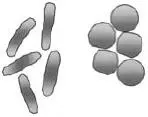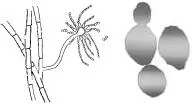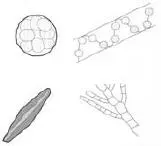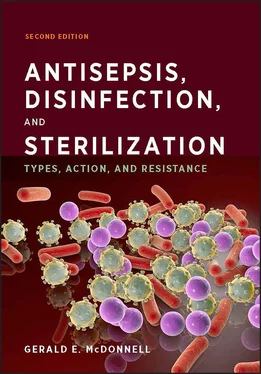Depyrogenation: The inactivation or removal of pyrogens.
Detergent: A surface-active agent (surfactant) that can emulsify oils and hold dirt in suspension; generally related to cleaning, where “detergents” can refer to cleaning mixtures that contain surfactants.
D value: The time required to achieve inactivation of 90% (or 1 log unit) of a population of a given test microorganism under stated conditions.
Endotoxin: Any of a class of toxins (or pyrogens) present in a microorganism but released only on cell disintegration. Specifically, a major component (lipopolysaccharide [LPS]) of the outer membrane in gram-negative bacteria.
Exotoxin: Any of a class of toxins produced by and secreted from a microorganism.
Formulation: Combination of ingredients, including active (biocide) and inert ingredients, into a biocidal product for its intended use (e.g., cosmetics, antiseptics, and disinfectants).
Fumigation: Delivery of an antimicrobial process (gas or liquid) indirectly to the internal surfaces of an enclosed area. An example is fogging, which is the indirect application of a biocidal liquid to a given area.
Germ: A general term referring to a microorganism.
Germicidal (noun, germicide): Able to kill microorganisms. In some countries, this specifically refers to bactericidal activity only.
Germination: The initiation of growth in a dormant spore.
Hydrophilic (polar): Able to attract and absorb water (“water loving”). Similar to lipophobic (“lipid hating”; avoiding lipid).
Hydrophobic (nonpolar): Having the properties of repelling and not absorbing water (“water hating”). Similar to lipophilic (“lipid loving”; having an affinity for lipid).
Parasite: An organism able to live on and cause damage to another organism.
Pathogen: A disease-causing organism.
Pasteurization: The antimicrobial reduction, usually by heat, of microorganisms that can be harmful or cause product spoilage.
Preservation: The prevention of the multiplication of microorganisms in products.
Pyrogen: A substance that can cause a rise in body temperature; for example, some exotoxins and endotoxins.
Resistance: The inability of an anti-infective or biocide to be effective against a target microorganism. See Tolerance.
Sanitization: The removal or inactivation of microorganisms that pose a threat to public health.
Secondary metabolites: Various products produced by microorganisms at the end of exponential growth or during stationary phase.
Sporulation: The process of spore development in microorganisms.
-Static: Suffix indicating the ability to inhibit the growth of a group of microorganisms (e.g., bacteriostatic means having activity to inhibit the growth of vegetative bacteria, and fungistatic means having activity to inhibit the growth of fungi). Compare to -cidal.
Sterile (noun, sterility): Free from viable organisms.
Sterilization:A defined process used to render a surface or product free from viable organisms, including bacterial spores.
Sterilizing agent: A physical or chemical agent (or combination of agents) that has sufficient microbicidal activity to achieve sterility under defined conditions.
Tolerance: A decreased effect of an anti-infective or biocide against a target microorganism, requiring an increased concentration or other modifications for it to be effective. Compare to Resistance.
Validation: A documented procedure for obtaining, recording, and interpreting the results required to establish that a process will consistently yield a product complying with predetermined specifications.
Viable: Alive and able to reproduce.
1.3 GENERAL MICROBIOLOGY
1.3.1 Introduction
Microbiology is the study of microscopic organisms, which include multicellular forms (helminths), unicellular forms (classified as eukaryotes and prokaryotes), and noncellular forms (e.g., viruses) ( Table 1.1).
Microorganisms play a large part in our daily lives, both for our benefit and to our detriment ( Table 1.2). The use of antiseptics, disinfectants, and sterilization methods is essential for control of the growth, multiplication, and transfer of microorganisms. Of particular concern are pathogenic, or disease-causing, organisms that can cause a variety of infections and stresses in humans, plants, and animals. A further consideration is the control of product contamination or spoilage, including that of foodstuffs and pharmaceutical drugs, which can have significant commercial consequences.
1.3.2 Eukaryotes and Prokaryotes
Eukaryotes and prokaryotes in their basic structure consist of single discrete cells. Cells are the basic units of life for these microorganisms, as well as the building blocks for multicellular organisms—plants and animals. Eukaryotes and prokaryotes are distinguished based on their microscopic structures; prokaryotes are considered much smaller and simpler in structure, while eukaryotes are larger and more organized ( Table 1.3). Eukaryotic cells include fungi, protozoa, algae, and human and plant cells. Prokaryotes include a diverse variety of eubacteria and archaea. Viruses are distinct and are considered separately, because they do not possess mechanisms for self-replication and depend on cells, in which they grow and multiply, for survival.
1.3.3 Eukaryotes
1.3.3.1 MULTICELLULAR EUKARYOTES
Multicellular eukaryotes include microscopic (or, indeed, macroscopic) arthropods and helminths (or worms). These are higher forms of life, composed of eukaryotic cells that are specialized into organs and structures. Arthropods are not considered further here, but some introduction is given to the helminths. Helminths are a diverse group of multicellular parasites and can be further classified as nematodes (roundworms) and platyhelminthes (flatworms). Over 20,000 species of nematodes have been defined, although it is estimated that 10 to 100 times this number possibly exist. The flatworms can be further separated into trematodes (flukes) and cestodes (tapeworms). Many helminths can be free-living in water environments (in particular, the roundworms), but most are parasitic in nature. Some of the key diseases caused by helminths are summarized in Table 1.4. Helminths reproduce sexually and have a typical associated life cycle ( Fig. 1.1).
Externally, the adult forms (including worms and flukes) are protected by a rigid proteinaceous (collagen) cuticle, which can resist the effects of biocidal processes; however, parasitic forms will not survive in the environment without their respective hosts (including, in some cases, intermediate hosts). Further, during their respective life cycles they produce dormant forms (including ova [eggs] or cysts) that can survive under harsh environmental conditions. Little work has been published on the structure of these eggs and their relative resistances to biocides, but microscopically they are diverse, consisting of various proteins and carbohydrates and having a variety of thicknesses (see section 8.11).
TABLE 1.1 Examples of various types of microorganisms
| Microorganism |
Typical structures a |
Size (μm) |
Nucleic acid |
Cell wall |
| Prions |
 |
<0.01 |
None |
No |
| Viruses |
 |
0.01–0.4 |
DNA or RNA |
No Envelope may be present |
| Chlamydias, rickettsias |
 |
0.3 |
DNA |
Minimal or simple cell wall |
| Mycoplasmas |
 |
0.1–0.3 |
DNA |
No |
| Bacteria |
 |
0.3–0.8 |
DNA |
Yes |
| Fungi |
 |
Yeast, 8–10 Fungi, >0.5 (wide), >5 (long) |
DNA |
Yes |
| Algae |
 |
1 – >1,000 |
DNA |
Yes/no (some) |
| Protozoa |
 |
10–200 |
DNA |
No |
| Helminths |
 |
>1,000 |
DNA |
NA b |
a Not to scale; simplified structures are shown. In addition, the basic structures of microorganisms can vary considerably based on their type, environmental conditions, and growth (or life cycle) phase.
Читать дальше





















